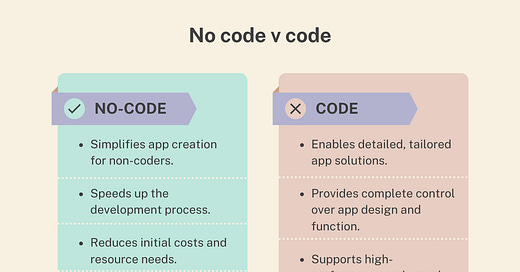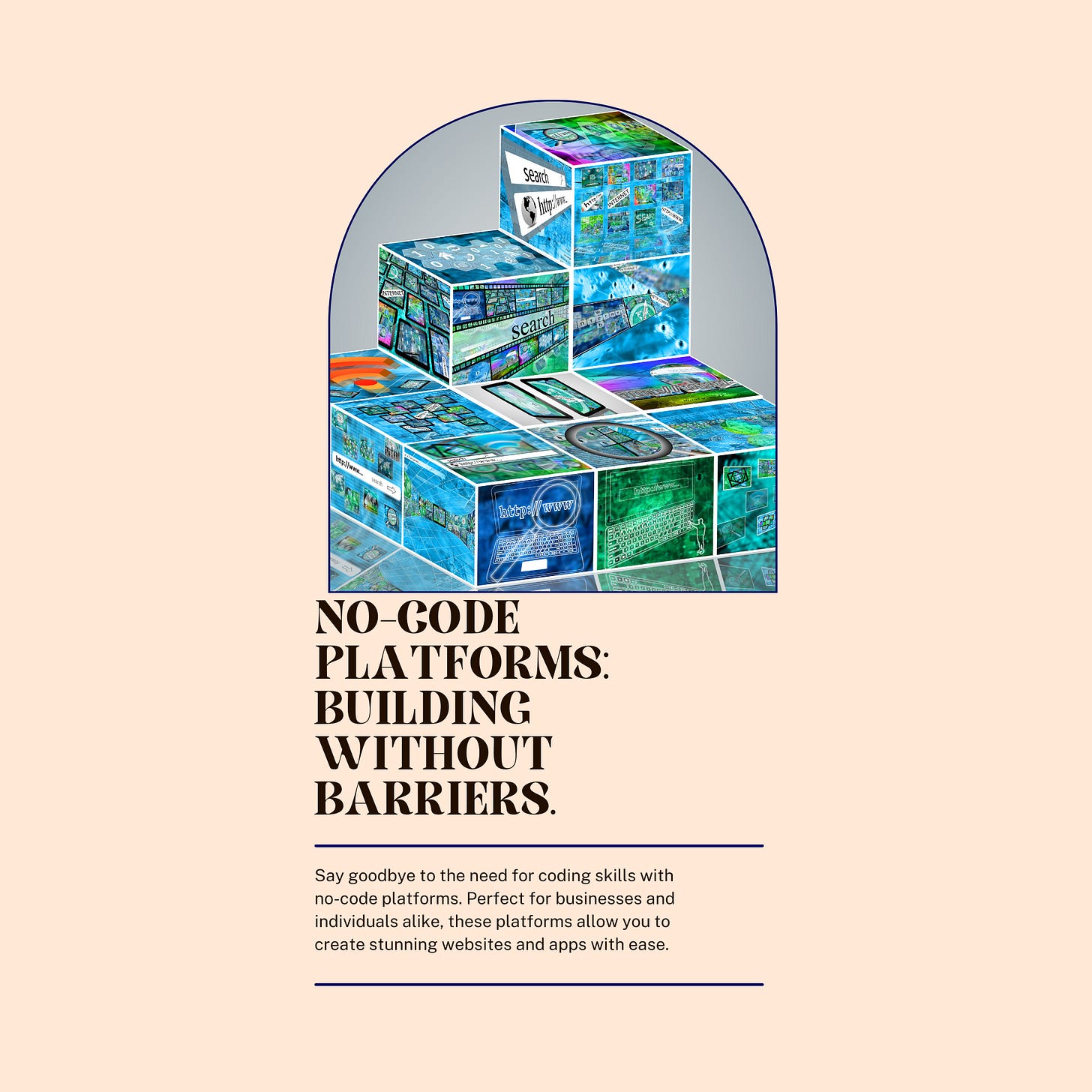Is Low-Code Development Diluting Programming Skills?
Join the debate on whether low-code platforms are a boon for productivity or a slippery slope towards devalued coding expertise.
Hey,👋 Sharif here! Welcome to this months ✌️ free edition ✌️ of Make.apps newsletter, packed with sizzling product dev tips, design trends, industry insights, top flows, and best practices.
Missed out? Here's a sneak peek at this month's content for non-subscribers:
Google rejected me because of this one simple thing
Dive into the world of apps. Design, develop, and launch with confidence
Patreon's Mobile App: A look at commenting and messaging
Subscribe to unlock all our resources
Todays outline
Introduction
Briefly explain low-code development.
Pose the central question of the impact of low-code on traditional coding skills.
The Emergence of Low-Code Platforms
Definition and rise of low-code development.
Current market trends and statistics.
The Allure of Low-Code
Benefits of low-code platforms for businesses and developers.
Case studies of successful low-code implementations.
The Purist’s Perspective
Arguments from traditional developers on the importance of hand-coding.
Potential risks of over-reliance on low-code solutions.
Low-Code vs. No-Code: Understanding the Distinctions
Differentiating between low-code and no-code.
The spectrum of coding involvement in app development.
The Skills Debate
Analysis of the skills required for low-code development.
How low-code platforms affect the job market for developers.
The Educational Impact
Low-code's influence on educational curriculums for software development.
Perspectives from educators and students.
The Future of Coding in a Low-Code World
Predictions and trends for the intersection of traditional coding and low-code platforms.
Conclusion
Summarize the main points.
Encourage continued discussion and exploration of the topic.
Introduction:
In the rapidly evolving digital landscape, the emergence of low-code development platforms has sparked a heated debate within the software engineering community. These platforms promise to streamline the app creation process, allowing users with minimal coding expertise to build applications quickly. But at what cost? Is this push towards accessibility diluting the very programming skills that have been the cornerstone of technological advancement?
As we peel back the layers of this argument, it's critical to examine not only the efficiency and innovation that low-code platforms bring to the table but also their potential impact on the coding craftsmanship. The question isn't merely whether low-code platforms are reshaping the industry but whether they are leading us down a slippery slope towards a future where the art of coding is devalued, and its artisans are left behind.
Investment in Low-Code Tools:
According to a study by KPMG, 26% of enterprises reported an increase in their investment in low-code development platforms as part of their digital transformation initiatives.
Many companies are now leveraging the efficiency of no-code and low-code platforms for product development, which still opens doors for developers to contribute meaningfully to their projects.
The Emergence of Low-Code Platforms: Low-code development platforms have been heralded as a significant leap forward, democratizing app development and enabling a broader range of professionals to contribute to the digital economy.
Market analysis from Forrester and Gartner predicts robust growth in the low-code development platform market, underscoring their rising influence.
The Allure of Low-Code: The allure of low-code development lies in its promise to reduce complexity, cost, and time to market for new applications.
By leveraging drag-and-drop interfaces and pre-built components, low-code platforms like OutSystems and Mendix have enabled companies to fast-track digital transformation initiatives.
FlutterFlow: FlutterFlow is a drag-and-drop builder for Flutter apps that's gaining traction for its flexibility and the robustness of its final product. It allows creators to design custom apps without deep diving into Dart—the language used by Flutter. It's a middle ground for those who want more control than a basic no-code tool but less grunt work than a full coding environment. It doesn't babysit you; instead, it offers a set of sophisticated tools and lets you take the wheel in crafting your app with a visual approach.
Adalo: Adalo pitches itself as the canvas for creators who want to bring app ideas to life without the coding barricade. It's part of the no-code movement, making app development as simple as putting together a slide deck. For those with zero coding background but a head full of ideas, Adalo is like a genie in a bottle. However, don't expect it to pump out a high-performance, massively scalable app. It's for those looking to validate ideas quickly and without fuss, not necessarily to disrupt the market with a tech masterpiece.
Glide: Glide is all about transforming spreadsheets into beautiful, easy-to-use apps. It's as if someone decided spreadsheets could be more than just cells and numbers and gave them a makeover to become interactive tools. Glide is for the pragmatists who want to see their data come alive without the rigmarole of backend development. It's powerful within its niche but doesn't pretend to be a one-stop shop for all app development needs. Think of it as the quick, smart solution for data-driven tools, not the path to the next social media giant.
Just some examples of no-code platforms
The adoption of low-code is becoming mainstream faster than many anticipated. Enterprises are flocking towards these platforms, with Gartner forecasting that by 2024, a dominating 65% of application development will be low-code-driven.
But what does this mean for productivity? An OutSystems survey indicates customers are experiencing a 6-fold increase in development speed compared to traditional coding methods. It's a game-changer, especially when considering the pace at which the digital world moves.
The Purist’s Perspective: Yet, for every advocate of low-code platforms, there's a purist who argues that these tools could never replace the nuance and capability of a seasoned coder. They argue that while low-code may suffice for simple applications, complex systems demand a depth of knowledge that only traditional coding can provide.
Low-Code vs. No-Code: Understanding the Distinctions: It's crucial to distinguish between low-code and no-code platforms, as the latter often requires no programming knowledge whatsoever.
This distinction emphasizes the varying degrees of technical involvement and expertise necessary across different development environments.
The Skills Debate: Low-code platforms are reshaping the skill set required for modern app development. While they may not require developers to write code from scratch, they demand a different kind of analytical and problem-solving skill set. Job postings on LinkedIn reflect a growing demand for professionals with low-code expertise.
The Educational Impact: The rise of low-code development is also influencing educational institutions. Programming courses are beginning to integrate low-code platforms into their curricula, suggesting a significant shift in the foundational skills being taught to the next generation of developers.
Conclusion:
The intersection of low-code platforms and traditional coding skills is a crossroads filled with both promise and precaution. While low-code development opens doors to innovation and inclusivity, it also brings forth questions about the future of coding as a craft.
Let’s see how no-code is taking the industry by storm. 🚀
No-code platforms offer substantial benefits for many, yet it's essential to acknowledge and address their inherent drawbacks.
Billion-Dollar Codeless Revolution
Pros:
Accessibility: Opens up app development to non-technical users, allowing for a more diverse set of creators.
Speed: Significantly reduces the time from concept to launch, enabling rapid prototyping and iterative design.
Cost-Efficiency: Cuts down on the resources needed for development, reducing overhead costs.
Empowerment: Gives business professionals, entrepreneurs, and educators the tools to solve problems directly, without waiting for IT department queues.
Innovation: Democratizes the creation process, potentially leading to innovative apps that might not have been developed in a code-heavy environment.
Maintenance: Most no-code platforms handle maintenance and updates, removing a layer of complexity for users.
Cons:
Performance Limitations: No-code apps may not perform as well as custom-coded ones, especially for complex tasks.
Customization Constraints: While they offer flexibility, there are limits to what you can achieve with no-code tools compared to traditional development.
Over-Reliance Risk: Reliance on vendor-specific platforms can lead to problems if the platform changes pricing, features, or goes out of business.
Scalability Concerns: No-code solutions may not be suitable for scaling up to a large number of users or handling massive data volumes.
Security and Compliance: There may be issues with data security and regulatory compliance, as control over these aspects can be limited.
Professional Development: Could potentially stunt the growth of traditional coding skills among new entrants into the development space.
While I personally believe the drawbacks eclipse the benefits, I still recognize situations where no-code solutions are appropriate and would consider their use.
Phew, what a journey we've had!
No-code platforms have emerged as powerful tools that democratize the ability to create, innovate, and bring ideas to life without the steep learning curve traditionally associated with app development.
They serve as a testament to the industry's evolution, catering to a wider audience and enabling a faster go-to-market strategy for new concepts.
However, traditional coding remains the backbone of technology, indispensable for crafting highly customized, robust, and scalable software solutions.
The depth of control and precision it offers cannot be fully replicated by no-code solutions. As we look to the future, it's evident that the most successful strategies may well involve a blend of both worlds, leveraging the speed and user-friendliness of no-code for certain tasks while relying on the power of traditional coding for others.
Ultimately, the decision to use no-code or traditional coding should be guided by the specific needs of the project, the goals of the developer, and the desired outcome. Embracing the strengths of each approach can lead to a more inclusive, efficient, and innovative development process, aligning with the ever-evolving demands of the tech industry.
Join the debate and let’s chat about it. I’m interested to know what are your thoughts on the no-code revolution.
We depend solely on our reader's generosity to keep delivering insightful app content. If you cherish truly independent insights, please consider supporting us.
✌️Thank you for reading. See you guys in a few days.
All the best,
Sharif






